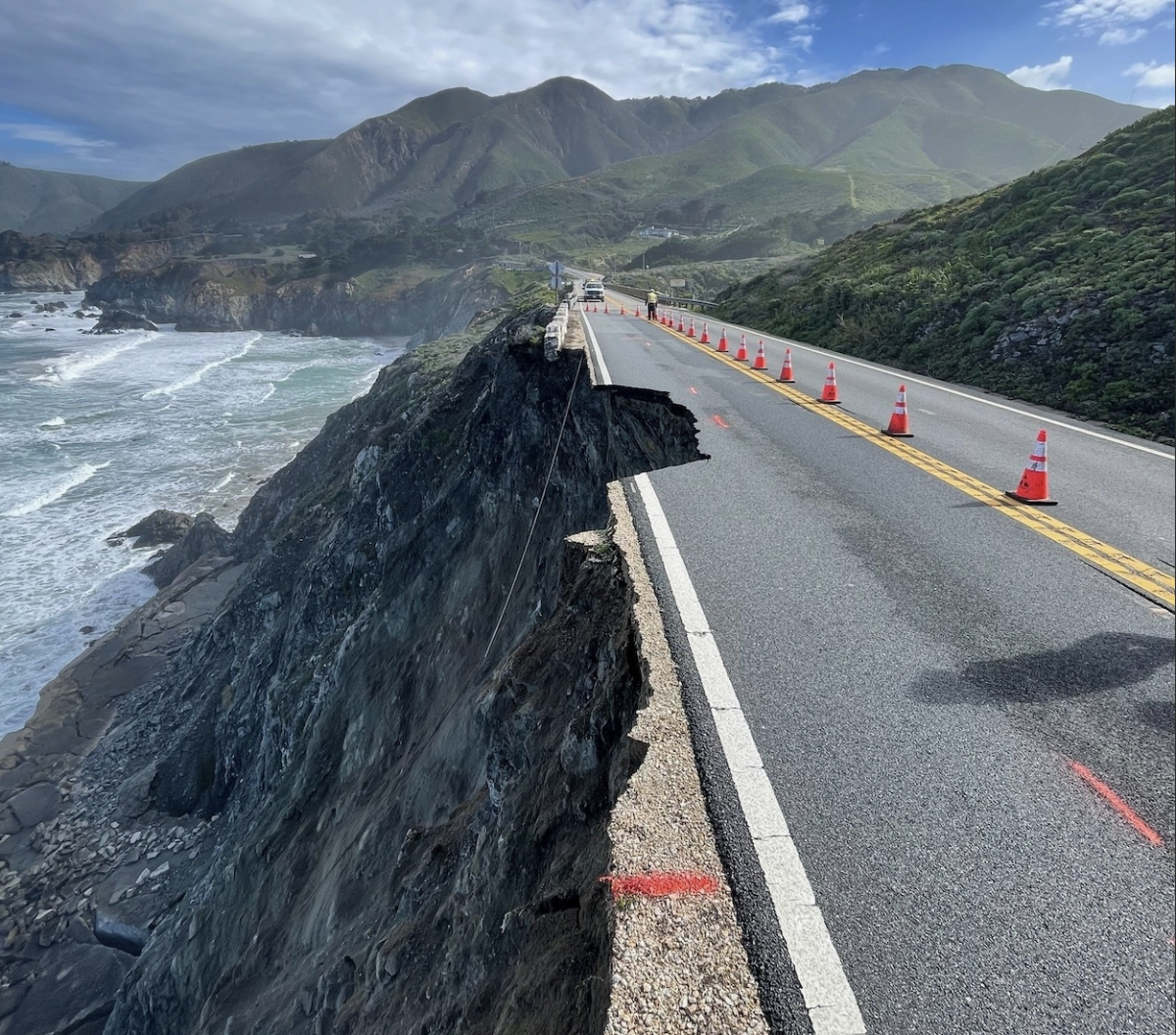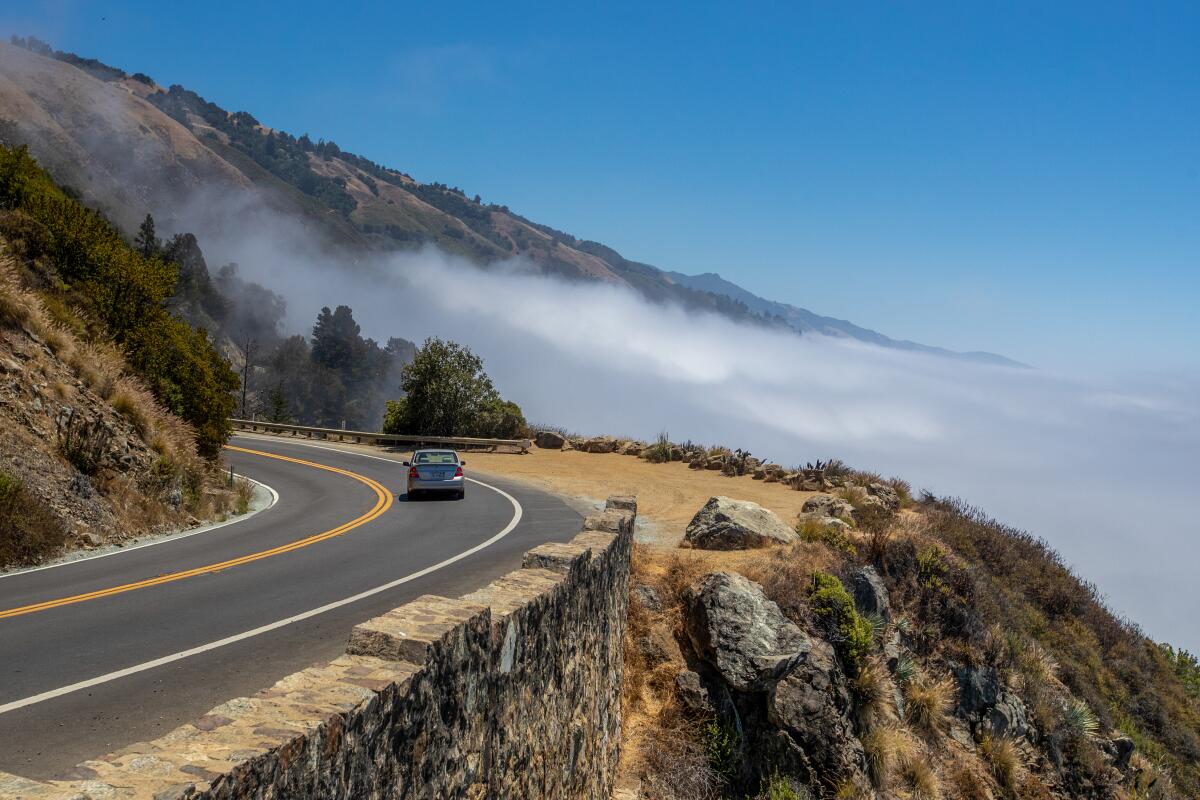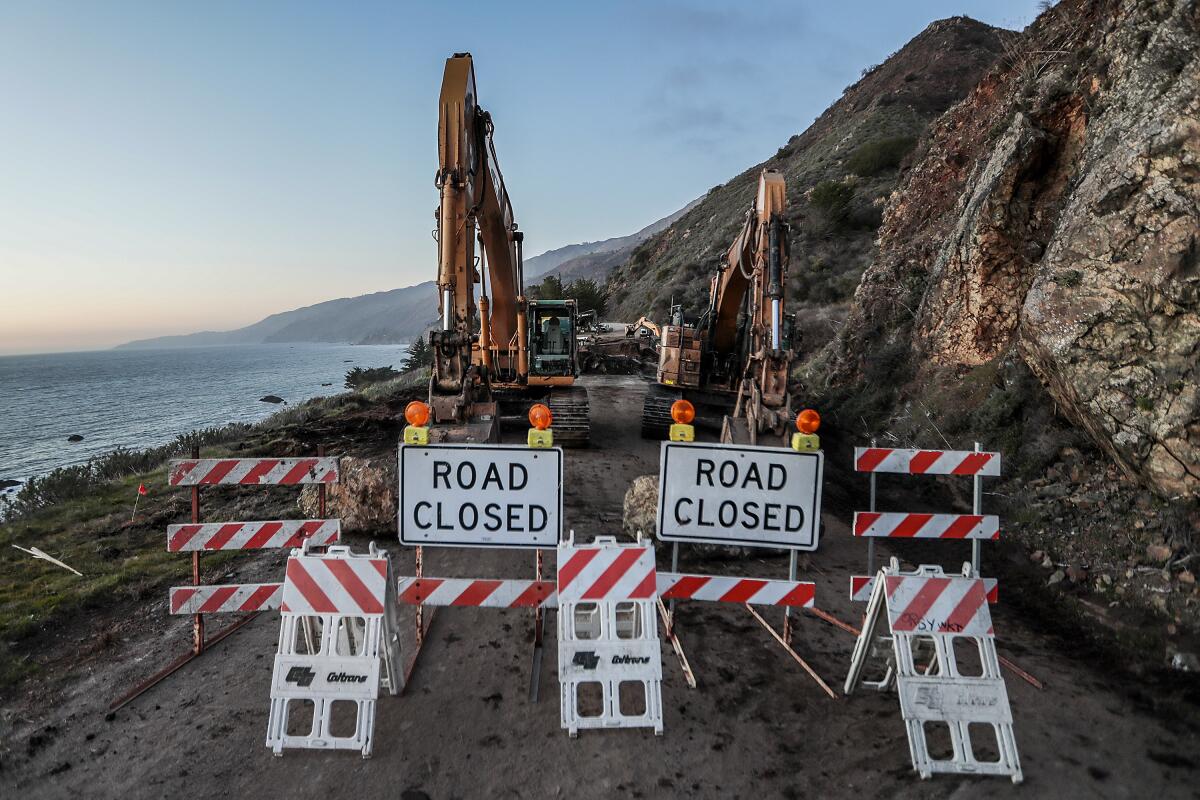We can’t stop Highway 1 from crumbling into the sea. Here’s why

- Share via
Good morning. It’s Wednesday, April 17. Here’s what you need to know to start your day.
- Highway 1 update and why we can’t stop it from crumbling into the sea
- The Supreme Court casts doubt on obstruction charges against hundreds of Jan. 6 rioters
- See James Dean’s apartment and more on the new TCM tour at Warner Bros.
- And here’s today’s e-newspaper.
You're reading the Essential California newsletter
Our reporters guide you through our biggest news, features and recommendations every morning
You may occasionally receive promotional content from the Los Angeles Times.
Built to spill: Why we can’t stop Highway 1 from crumbling into the sea
We have an update on Highway 1, which has been closed south of the Rocky Creek Bridge after a landslide sent part of the cliff and road into the Pacific Ocean.
State transportation officials closed about a mile of the highway March 31, initially stranding more than 1,000 tourists and residents. Supervised convoys have been running through the area ever since.
The California Department of Transportation anticipates that the affected section will reopen by Memorial Day, though with limited capacity. Drivers in both directions will take turns using the northbound lane via a 24/7 traffic signal.
Meanwhile, Caltrans crews will be reinforcing the road and cliffside with rock dowels — giant screw-like anchors used to stabilize weakened rocks — then fill the lost chunk by spraying shotcrete.
Researchers with the U.S. Geological Survey analyzed the affected area and determined that the damage was caused by a common rockfall.
“The good news is that researchers didn’t see a larger landslide at work, which would suggest greater instability in the surrounding area,” my colleague Grace Toohey reported this week. “The bad news is that it’s an ongoing challenge to predict where and when another rockfall could happen along Highway 1 — the stretch of highway that the USGS considers most vulnerable to coastal erosion in California.”
That challenge was there before the highway fully opened in 1937. A Times reporter chronicling the progress of what was then referred to as the Carmel-San Simeon Highway said road builders had “invaded the last coastal frontier in California.”
“It will result in a masterpiece of highway construction,” the reporter wrote in 1935. “Our new scenic and spectacular coast highway … is destined to become a touring Mecca of America.”
But chunks of this “masterpiece” have a tendency to fall into the sea. A historical report presented to Caltrans in 2001 documented more than 50 closures on Highway 1 between 1935 and 2000. Most were for landslides and debris flows, plus a few wildfires.

Since 2009, approximately 50 slides have been recorded in the stretch between Monterey and San Simeon, according to Caltrans spokesperson Chris Clark.
The same features that give the Central California coastline its majestic views also make it volatile.
As Gary Griggs, a professor of earth sciences at UC Santa Cruz, explained, that is mainly because California is young — in a geological sense — and still settling in.
“It’s where two giant tectonic plates have collided for millions of years,” he told me this month. “We have a very active landscape, weak rocks and very steep slopes along the Big Sur coast that have been and will continue to be impacted by intense rainfall, often after fires, and also wave attack along the shoreline.”
It’s not as if Caltrans is not aware of this.
“Over a long period of time (from the mid-1930s to the present), road closures have been one of the few constants of life in Big Sur,” historical consultants noted in a report presented to the agency in 2001. “The historic record suggests that closures will continue into the future on a reasonably predictable basis, with major closures coming in clusters that coincide with wet weather patterns and summertime fire events.”
So what is Caltrans doing about it? It will continue to rebuild and repair the parts of Highway 1 that crumble away, Clark said, but “make it more adaptable and more resilient to climate change.”
“There are few, if any, more iconic routes, not just in California but anywhere in the world,” Clark said. “It’s the Main Street of Big Sur. What this road means to the local economy, to the people of this region and to our pride as Californians is simply invaluable.”
What do those adaptive designs look like? Clark said Caltrans is installing larger culverts “to enable the passage of increased flows,” adding “debris catchments” to prevent clogged drainage systems and “looking toward nature-based solutions about designing ways to let nature do what nature wants to do safely.”

I asked Griggs, whose research focuses on coastal hazards and engineering responses, about the state’s solutions so far. He called Caltrans’ seemingly constant repair work “a Band-Aid” that will never fix the uncontrollable force that is nature.
“[Fixes] may last months or years, but failure will occur elsewhere during the next major storm,” he said. “A changing climate will produce hotter, drier summers, which makes the landscape more prone to wildland fires, and also more concentrated winter rainfall and runoff that will lead to more frequent landslides and debris flows.”
And the cost of all those repairs adds up. A list of nearly 50 projects shared by Caltrans totals more than $400 million since 2009. Storm repair work along Highway 1 in 2021 reportedly cost $11 million, while the major incident in 2023 that has kept a southern section of Highway 1 closed for more than a year has an estimated price tag of $88 million, Caltrans told the San Francisco Chronicle.
Griggs floated the idea of making Highway 1 a toll road, like what’s in place to access the similarly scenic 17-Mile Drive. Charging the millions of motorists estimated to drive Highway 1 each year “could raise some serious repair money,” he said.
And if Highway 1 is to stay open (sometimes) as the risks of its already-risky terrain intensify during a growing climate crisis, it’s going to need all the money it can get.
Today’s top stories

Housing for the homeless
- L.A. Mayor Karen Bass urges business and philanthropic leaders to help fund housing for homeless people.
- Sun Valley housing project offers stability to homeless families in LAUSD.
- A controversial landlord wants to buy six more troubled Skid Row properties.
Coachella
- Coachella is bigger than ever. Where to find the best food spots for Weekend 2.
- The best moments of Coachella 2024 in photos.
- The 15 best things we saw.
WNBA draft
- Caitlin Clark is worth millions. Why will she only make $76,535 in the WNBA?
- The Clark show is coming to the WNBA: 36 of Fever’s 40 games will be on national TV.
- After Clark is drafted at No. 1, Sparks select Cameron Brink and Rickea Jackson.
More big stories
- USC valedictorian’s graduation speech is canceled: ‘The university has betrayed me.’
- Renters across L.A. are under strain and many fear becoming homeless, survey finds.
- O.J. Simpson never paid the Goldmans the millions he owed them. Can they finally collect?
- Abortion ban has supercharged Arizona politics. What will GOP legislators do?
- Former L.A. Councilmember Jose Huizar is granted a delay for his 13-year prison term.
- He shot an 18-year-old in the back of the head. A jury couldn’t decide if it was murder.
- Women at a California prison dubbed the ‘rape club’ worry where they’ll be transferred.
- The Supreme Court casts doubt on obstruction charges against hundreds of Jan. 6 rioters.
- News publishers’ alliance calls on feds to investigate Google for limiting California links.
- The EV market is in trouble: The latest sign is Tesla layoffs.
- Disneyland’s plan to expand and reimagine the park with new rides and hotels goes to a vote.
- Carl Erskine, Dodgers pitcher in both Brooklyn and L.A., has died at 97.
Get unlimited access to the Los Angeles Times. Subscribe here.
Commentary and opinions
- Michael Hiltzik: With his Truth Social stock, Trump may be laughing all the way to the bank — but his investors have reason to weep.
- Anita Chabria: Paris Hilton came to talk about ‘abuse disguised as therapy.’ We both teared up.
- Editorial Board: If 10 straight months of record-breaking heat isn’t a climate emergency, what is?
- Meredith Blake: ‘The Golden Bachelor’ divorce turns a TV success story into a cautionary tale.
- Robin Abcarian: A disconcerting wave of crime in Venice, caught on camera.
Today’s great reads

This trans author toured red-state libraries. What she found might surprise you. “The goal of My Red-State Library Tour was to defend an institution I loved and to send the message that the book bans are a fascist-style campaign of cultural erasure, which our media has failed to grasp,” Diana Goetsch writes. “I don’t know if I succeeded, though I would love for there to be copycats — other authors who travel to libraries to speak, repaying the favors they do for us.”
Other great reads
- ‘It’s the best job ever’: ‘Family Guy’ cast reflects on 25 years of irreverent humor.
- Did you feel that L.A. earthquake? Here’s why you might be a ‘never-feeler.’
- It’s time for an Oscar for stunts. ‘The Fall Guy’ is the best argument for it.
- 1 million Mexican Americans were deported a century ago. A new L.A. audio tour explores this ‘hidden’ history.
How can we make this newsletter more useful? Send comments to essentialcalifornia@latimes.com.
For your downtime

Going out
- 🌼 This iconic wildflower spot can be dazzling. Is it worth the trek from L.A. this year?
- 🍴The team behind Michelin-recognized Liu’s Cafe opens an ode to modern Korean favorites.
- 🎥 Classic film lovers: See James Dean’s apartment and more on the new TCM tour at Warner Bros.
Staying in
- 📕He wasn’t a crier, but then his wife died — and the tears wouldn’t stop. How one father found his way forward.
- 📺 Lily Gladstone and Riley Keough shine in Hulu’s dark true-crime drama ‘Under the Bridge.’
- 🥦 Here’s a recipe for broccoli with pumpkin seed jazz.
- ✏️ Get our free daily crossword puzzle, sudoku, word search and arcade games.
And finally ... a great photo
Show us your favorite place in California! We’re running low on submissions. Send us photos that scream California and we may feature them in an edition of Essential California.
Today’s great photo is from Times photographer Christina House at the first weekend of Coachella.
Have a great day, from the Essential California team
Ryan Fonseca, reporter
Defne Karabatur, fellow
Kevinisha Walker, multiplatform editor and Saturday reporter
Christian Orozco, assistant editor
Karim Doumar, head of newsletters
Check our top stories, topics and the latest articles on latimes.com.
Sign up for Essential California
The most important California stories and recommendations in your inbox every morning.
You may occasionally receive promotional content from the Los Angeles Times.








